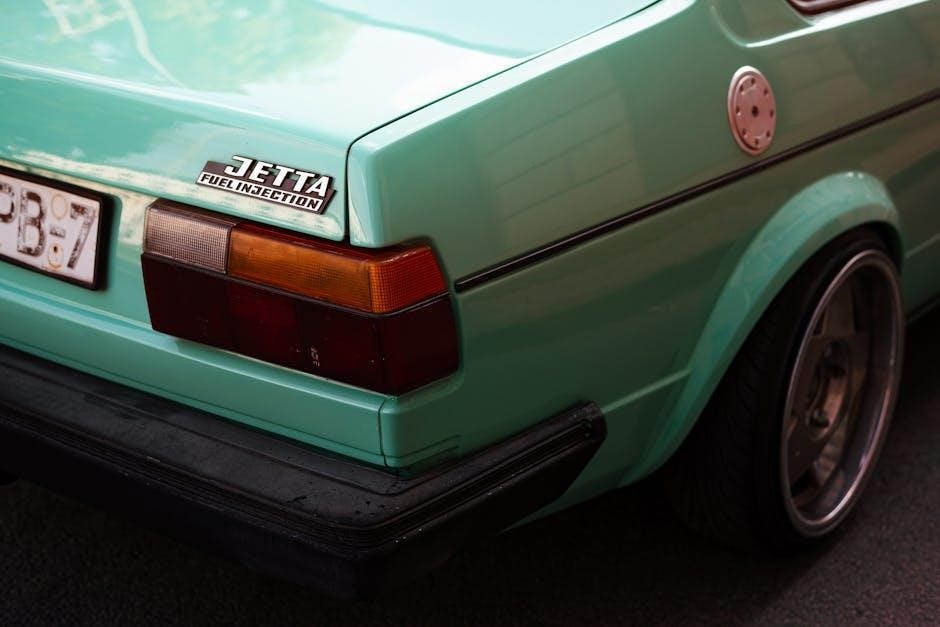
The 2013 VW Jetta Fuse Box Diagram is a comprehensive guide to understanding your vehicle’s electrical system, providing detailed layouts for easy fuse and relay identification.
1.1 Importance of Understanding Fuse Box Layout
Understanding the fuse box layout of your 2013 VW Jetta is crucial for maintaining and repairing its electrical system. The fuse box diagram provides a clear map of fuse locations, ensuring quick identification of blown fuses. This knowledge helps prevent electrical overloads and short circuits, protecting critical vehicle components. By familiarizing yourself with the layout, you can diagnose issues efficiently, saving time and reducing the risk of further damage. It also empowers you to perform DIY repairs confidently, avoiding costly professional assistance. A clear understanding of the fuse box layout is essential for safe and effective troubleshooting, ensuring your vehicle operates reliably.
1.2 Brief Overview of the 2013 VW Jetta Electrical System
The 2013 VW Jetta’s electrical system is designed to power various components efficiently. It relies on fuses and relays to protect circuits from overloads. The system is divided into two main fuse boxes: one under the hood and another in the passenger compartment. These boxes house fuses and relays that control everything from lighting to advanced electronics. The electrical system ensures proper functionality of safety features, infotainment, and engine management systems. Understanding this setup is vital for troubleshooting and maintaining your vehicle’s performance and reliability. Regular checks of the electrical system can prevent unexpected issues and ensure optimal operation.
Locations of Fuse Boxes in the 2013 VW Jetta
The 2013 VW Jetta features two primary fuse boxes: one located under the hood and another in the passenger compartment, ensuring easy access for maintenance and repairs.
2.1 Fuse Box Under the Hood
The fuse box under the hood of the 2013 VW Jetta is located on the driver’s side, near the battery. It contains fuses and relays that protect essential electrical systems, such as the engine, cooling, and ABS. This box is crucial for maintaining the vehicle’s performance and safety. Accessing it requires no tools, as the cover is held by clips. The fuse box diagram provides a detailed layout, identifying each fuse’s purpose, which simplifies troubleshooting issues like blown fuses for components like the alternator or fuel pump. Regular inspection ensures reliable operation of critical vehicle functions.
2.2 Passenger Compartment Fuse Box
The passenger compartment fuse box in the 2013 VW Jetta is located on the driver’s side, behind the trim panel near the glovebox. It houses fuses for interior components like lights, infotainment, and windshield wipers. Accessing this fuse box requires removing the trim panel, which is a straightforward process without tools. The fuse box diagram provides a clear layout, helping identify each fuse’s function. This makes diagnosing issues, such as blown fuses for the radio or climate control, easier. Regular checks ensure reliable operation of essential interior features, enhancing overall driving comfort and convenience.

Detailed Fuse Box Diagrams
The 2013 VW Jetta Fuse Box Diagram PDF provides clear layouts for the engine compartment and interior fuse boxes, ensuring easy identification of fuses and their functions.
3.1 Engine Compartment Fuse Box Diagram
The engine compartment fuse box diagram for the 2013 VW Jetta details the layout and function of each fuse and relay in the under-hood fuse box. This diagram is essential for diagnosing electrical issues related to engine components, such as the cooling fan, ABS system, and fuel pump. By referencing the PDF, you can identify which fuse corresponds to specific functions, ensuring quick and accurate troubleshooting. The diagram also highlights the location of high-current fuses, which protect critical systems from overloads. This resource is invaluable for both DIY enthusiasts and professional mechanics.
3.2 Interior Fuse Box Diagram
The interior fuse box diagram for the 2013 VW Jetta provides a detailed layout of the fuses located in the passenger compartment. Positioned on the driver’s side, this fuse box controls essential systems like interior lighting, infotainment, and climate control. The PDF guide offers a clear visual representation, labeling each fuse with its corresponding function. This diagram is crucial for diagnosing issues with accessories and comfort features. By referencing the color-coded fuses and their positions, you can quickly identify and replace faulty fuses. The interior fuse box diagram ensures precise troubleshooting, helping you restore functionality to your vehicle’s interior systems efficiently.

Functions of Fuses and Relays

Fuses protect electrical circuits from overloads, while relays control power distribution to various components. Together, they ensure safe and efficient operation of the vehicle’s electrical systems.
4.1 Role of Fuses in Electrical Circuits
Fuses are essential components in the 2013 VW Jetta’s electrical system, acting as protective devices that prevent damage from overloads or short circuits. They are designed to melt when excessive current flows through a circuit, thereby breaking the connection and safeguarding the system. Each fuse corresponds to specific components or systems, ensuring that only the affected circuit is interrupted. This targeted protection minimizes disruption and allows for quick identification and replacement of faulty fuses. Regular inspection of fuses is crucial for maintaining reliable vehicle operation and preventing potential electrical failures.
4.2 Purpose of Relays in the Electrical System
Relays in the 2013 VW Jetta serve as electronic switches, enabling low-power signals to control high-power electrical circuits. They amplify the signal strength, reducing the load on the battery and wiring. Relays ensure efficient power distribution, preventing overheating and electrical failures. By isolating control circuits from high-current loads, they protect sensitive components and enhance system reliability. This design allows for precise control of accessories like lights, fans, and fuel pumps, ensuring optimal performance and longevity of the vehicle’s electrical system. Regular inspection of relays is crucial for maintaining seamless operation and diagnosing issues promptly.
How to Read the Fuse Box Diagram
Start by locating the fuse boxes, typically under the hood and inside the passenger compartment. Open them using the release latch. Refer to the fuse box diagram, which maps each fuse’s location and function. Use the key or legend to interpret symbols, such as a headlight icon for the corresponding fuse. Identify blown fuses by checking for breaks in the filament. Test fuses using a multimeter for continuity. Replace blown fuses with ones of the same rating. Understand relays as electronic switches controlling power flow. Consult the diagram to trace circuits for underlying issues. Ensure safety by disconnecting the battery before working. Handle components carefully to avoid damage. This process enables effective troubleshooting and maintenance of your vehicle’s electrical system.
5.1 Understanding Fuse Layout and Symbols
The 2013 VW Jetta fuse box diagram provides a clear layout of fuses and their functions. Locate the fuse boxes under the hood and in the passenger compartment. Open the fuse box by releasing the latch. Refer to the diagram for fuse locations, labeled with numbers or icons representing their functions, such as headlights or wipers. Symbols may indicate relays or higher-current fuses. Use the key or legend on the diagram to interpret these symbols. Each fuse is color-coded by amp rating, helping you identify the correct replacement. Testing fuses with a multimeter can confirm if they are blown. Always match the amp rating when replacing fuses to ensure proper function and safety.
5.2 Interpreting Relay Information
Relays in the 2013 VW Jetta are essential for controlling high-current electrical components. The fuse box diagram identifies relays by their locations and functions, often labeled with descriptions like “Headlight Relay” or “Fan Relay.” Each relay is typically represented by a box symbol with terminal points. Use the diagram’s legend to match relay positions with their purposes. Relays are usually found in the engine compartment fuse box or interior fuse box. Refer to the diagram’s key to understand relay functions and wiring connections. This helps in diagnosing issues like faulty relays causing lights or fans to malfunction. Always consult the diagram before replacing relays.
Troubleshooting Electrical Issues

The 2013 VW Jetta Fuse Box Diagram is essential for diagnosing electrical problems, helping identify blown fuses or faulty relays and guiding quick repairs to prevent further damage.
6.1 Common Electrical Problems and Solutions
Common electrical issues in the 2013 VW Jetta include blown fuses, faulty relays, and malfunctioning components like the 12V connector or interior lights. Blown fuses often result from overloaded circuits or short faults. Faulty relays can cause systems like the fuel pump or ABS to fail. Solutions involve identifying the problematic fuse or relay using the fuse box diagram, replacing it with the correct rating, and addressing the root cause to prevent recurrence. Regular inspection of the fuse box and electrical connections can help mitigate these issues early. Always consult the diagram to ensure accurate troubleshooting and repairs.
6.2 Step-by-Step Troubleshooting Guide
To troubleshoot electrical issues in your 2013 VW Jetta, start by identifying the symptom, such as a malfunctioning component or warning light. Consult the fuse box diagram to locate the relevant fuse or relay. Inspect the fuse for signs of damage or blown status. If a fuse is blown, replace it with one of the same rating. For relays, test for continuity or swap with a known good one. Use a multimeter to check for power at the component and wiring connections. Address the root cause, such as repairing short circuits or replacing faulty components. Regularly inspecting the fuse box and connections can prevent future issues.
Common Fuse Box Issues in the 2013 VW Jetta
Common issues include blown fuses, faulty relays, and electrical faults, often caused by overloaded circuits, worn connections, or damaged components, requiring prompt identification and repair.
7.1 Frequently Blown Fuses and Their Causes
In the 2013 VW Jetta, certain fuses are more prone to blowing due to high electrical demand or component failures. The 12V outlet fuse often blows from overloaded accessories, while the ABS control module fuse may fail due to system malfunctions. Additionally, the rear window defroster fuse can blow if there’s damage to the defroster grid or excessive use. Blown fuses can also result from short circuits in wiring or faulty relays. Identifying the root cause is crucial to prevent recurring issues and ensure proper electrical system functionality.
7.2 Identifying Faulty Relays
Faulty relays in the 2013 VW Jetta can cause electrical system malfunctions. Common signs include clicking noises from the relay, intermittent operation of components like the fuel pump or ABS, or complete failure of systems. To identify a faulty relay, consult the fuse box diagram to locate the relevant relay. Test the relay by swapping it with a known good one or using a multimeter to check for continuity and proper resistance. If the relay fails to activate or shows open circuits, it should be replaced. Regular inspection of relays can prevent unexpected electrical issues and ensure reliable vehicle operation.

Replacing Fuses and Relays
Replacing fuses and relays in the 2013 VW Jetta requires proper identification using the fuse box diagram. Ensure correct replacements to avoid electrical system damage or malfunction.
8.1 Safe Fuse Replacement Procedure
To safely replace a fuse in your 2013 VW Jetta, start by turning off the ignition and all electrical components. Locate the fuse box using the diagram provided in your owner’s manual or the PDF guide. Identify the faulty fuse and pull it out gently using a fuse puller. Inspect the fuse for signs of damage or wear. Replace it with a new fuse of the same amperage rating to ensure proper electrical flow. Avoid using a fuse with a higher rating, as it may cause damage to the system. Finally, test the affected component to confirm the issue is resolved.
8.2 Guidelines for Relay Replacement
When replacing a relay in your 2013 VW Jetta, refer to the fuse box diagram to identify the correct relay location. Ensure the ignition is off to prevent electrical shocks. Remove the relay by gently pulling it out of its socket. Inspect the new relay for any visible damage before installation. Insert the replacement relay firmly into the socket, making sure it clicks into place. Avoid forcing it, as this could damage the connector. Turn the ignition on and test the related system to confirm proper function. Always use a relay with the same specifications as the original to maintain system integrity.
Safety Tips When Working with the Fuse Box
Always disconnect the battery before working on the fuse box to prevent electrical shocks. Use insulated tools and avoid short circuits to ensure safe repairs.
9.1 Precautions to Avoid Electrical Shock
When working with the 2013 VW Jetta fuse box, always disconnect the battery first to prevent electrical shocks. Use insulated tools to handle fuses and relays. Avoid touching live circuits or components with bare hands. Ensure the vehicle is in park and apply the parking brake. Never work on the fuse box in wet conditions, as moisture increases the risk of electrical shock. If unsure, consult the owner’s manual or a professional. Always follow proper grounding procedures and avoid bypassing safety features. These precautions ensure a safe working environment when diagnosing or repairing electrical issues.

9.2 Best Practices for Handling Fuses and Relays
Always use the correct tools when handling fuses and relays to avoid damage. Refer to the 2013 VW Jetta fuse box diagram for proper identification. Handle fuses gently to prevent bending or breaking. When replacing a fuse, ensure it matches the amperage rating specified in the diagram. Test fuses with a multimeter before installation to confirm functionality. Dispose of blown fuses responsibly. For relays, avoid touching electrical contacts to prevent corrosion. If unsure about any procedure, consult the owner’s manual or seek professional assistance. Proper handling ensures the longevity and reliability of your vehicle’s electrical system.

Additional Resources for Fuse Box Information
Download the official 2013 VW Jetta Fuse Box Diagram PDF for detailed layouts and relay information. Visit websites like fuse-box.info for additional resources and guides.
10.1 Downloading the Official 2013 VW Jetta Fuse Box PDF
The official 2013 VW Jetta Fuse Box Diagram PDF is available for download from Volkswagen’s website or trusted automotive resources like fuse-box.info. This PDF provides detailed fuse and relay layouts, ensuring accurate identification and troubleshooting. It covers both engine compartment and interior fuse boxes, listing each fuse’s function. Additionally, forums and repair websites offer free access to these diagrams. Downloading this PDF is essential for DIY repairs and maintaining your vehicle’s electrical system efficiently. Ensure the source is reliable to avoid incorrect or outdated information.
10.2 Recommended Online Tools and Websites
Several online tools and websites provide reliable resources for the 2013 VW Jetta fuse box diagram. Websites like fuse-box.info and myturbodiesel.com offer detailed fuse diagrams and repair guides. Additionally, forums such as GolfMK6 and 1aauto.com provide interactive troubleshooting and DIY tutorials. These platforms are invaluable for accessing accurate fuse box information and resolving electrical issues efficiently. They also offer downloadable PDFs and step-by-step instructions, making them essential resources for car owners and mechanics alike. Using these tools ensures you have the most up-to-date and accurate information for your vehicle.

Understanding the 2013 VW Jetta fuse box diagram is essential for maintaining and repairing your vehicle’s electrical system efficiently and safely, ensuring reliability and optimal performance always.
11.1 Summary of Key Points
The 2013 VW Jetta fuse box diagram is a vital resource for understanding and maintaining your vehicle’s electrical system. It provides detailed layouts of fuse and relay locations, ensuring easy identification and troubleshooting. By referencing the diagram, you can locate specific fuses for components like lights, wipers, and electronics, simplifying repairs. Regular inspection of fuses and relays helps prevent electrical issues. Always refer to the official PDF guide for accurate information. Safe handling practices and proper replacement procedures are crucial to avoid damage or electrical hazards. This guide empowers owners to diagnose and resolve issues efficiently, keeping their Jetta running smoothly and reliably.
11.2 Final Tips for Maintaining Your Vehicle’s Electrical System
Regularly inspect your 2013 VW Jetta’s fuses and relays to prevent electrical failures. Avoid overloaded circuits and ensure all repairs are done with genuine parts. Always disconnect the battery before working on the electrical system to prevent shocks. Refer to the official fuse box diagram PDF for accurate fuse assignments and relay locations. Keep a spare set of fuses in your car for emergencies. Schedule periodic checks by a certified technician to identify potential issues early. By following these tips, you can maintain your vehicle’s electrical system efficiently, ensuring reliability and safety on the road.

Frequently Asked Questions (FAQs)
Where are the fuse boxes located in a 2013 VW Jetta? How do I read the fuse box diagram? What causes fuses to blow frequently? Find answers here.
12.1 Common Questions About Fuse Box Diagrams
Where are the fuse boxes located in a 2013 VW Jetta? The fuse boxes are typically found under the hood and inside the passenger compartment. What do the diagrams include? They provide detailed layouts of fuses, relays, and their functions. Can I download a PDF of the fuse box diagram? Yes, the official 2013 VW Jetta fuse box diagram is available for free online. How do I identify which fuse corresponds to a specific component? The diagram assigns each fuse to its function, making it easier to locate and replace. Are the diagrams applicable to other model years? Many diagrams cover 2010-2017 models, ensuring broader applicability. How can I troubleshoot using the diagram? By cross-referencing symptoms with fuse locations, you can identify potential issues. Are the diagrams user-friendly? They are designed to be clear and accessible, even for those with limited electrical knowledge. Can I print the diagram for easier reference? Absolutely, it’s recommended to have a physical copy for hands-on repairs. Does the diagram include relay information? Yes, it details both fuses and relays for comprehensive understanding. How often should I check the fuses? Regular checks can prevent electrical system overload and ensure optimal vehicle performance. Are there safety precautions when handling fuses? Always disconnect the battery before working with fuses to avoid electrical shock. Can I use the diagram for DIY repairs? Yes, it’s an essential tool for DIY enthusiasts and professionals alike. How do I know if a fuse is blown? Look for visible signs like a broken filament or use a multimeter to test continuity. Can I replace a blown fuse myself? Yes, with the correct replacement fuse and basic tools. Are all fuses the same size and type? No, fuses have different ratings, so always use the specified type for your vehicle. How do I prevent fuses from blowing frequently? Address underlying issues like short circuits or overloaded circuits. Is the diagram available in multiple languages? Many resources offer English versions, but check for translations if needed. Can I find video tutorials to complement the diagram? Yes, online resources like 1A Auto provide step-by-step guides. How do I ensure I’m using the correct diagram for my model? Verify the model year and vehicle type before downloading. Are there any additional tools recommended for working with fuses? A fuse puller is handy for safe removal and installation. Can I request a hard copy of the diagram? Some resources may offer printed versions, but digital access is most common. How do I update my diagram if I modify my vehicle’s electrical system? Custom diagrams may be needed, consult a professional for accurate updates. Are there forums or communities for further support? Yes, forums like GolfMK6 and MyTurbodiesel offer discussions and shared resources. Can I share the diagram with others? Most resources are free to share, but always credit the source. How do I report errors or inaccuracies in the diagram? Contact the provider or community forums for corrections. Is the diagram compatible with all trim levels? Check specifications to ensure compatibility with your vehicle’s trim. How do I access the diagram on my mobile device? Most PDFs are mobile-friendly, allowing on-the-go reference. Can I bookmark specific sections for quick access? Yes, digital versions often support bookmarks for easy navigation. How do I ensure I’m following the latest updates? Regularly check the source for revised versions. Are there any costs associated with accessing the diagram? Most resources are free, but some premium tools may require payment. Can I use the diagram for educational purposes? Absolutely, it’s a valuable resource for learning about automotive electrical systems. How do I provide feedback on the diagram’s clarity? Use the provided channels on the resource website or forums. Can I customize the diagram for my needs? Basic editing software can help, but ensure accuracy is maintained. How do I ensure I’m not violating any copyrights? Always use diagrams from reputable sources and respect copyright notices. Can I integrate the diagram into my vehicle’s service manual? Yes, for a comprehensive reference guide. How do I stay updated on new fuse box diagrams? Subscribe to newsletters or follow forums for the latest updates. Can I request a fuse box diagram for older models? Some resources archive diagrams for older vehicles, check availability. How do I know if my vehicle has additional fuse boxes? Consult the diagram or owner’s manual for specific locations. Can I use the diagram to teach others about car maintenance? It’s an excellent educational tool for workshops or classes. How do I ensure I’m not missing any critical information? Cross-reference with multiple sources to confirm accuracy. Can I translate the diagram into another language? Use online translation tools, but verify technical accuracy. How do I report a blown fuse that’s not listed? Consult a professional or refer to additional resources. Can I use the diagram to diagnose issues in other Volkswagen models? Some diagrams overlap, but verify model-specific details. How do I ensure I’m using the correct tools for fuse replacement? Refer to the diagram or owner’s manual for recommendations. Can I find a fuse box diagram for international models? Some resources cater to global models, check for availability. How do I ensure I’m not damaging the electrical system? Follow proper procedures and safety guidelines. Can I use the diagram to upgrade my vehicle’s electrical system? Consult professionals for custom modifications. How do I ensure I’m not missing any fuses during replacement? Double-check the diagram and fuse locations. Can I request a fuse box diagram for a specific trim or package? Some resources offer detailed breakdowns, check availability. How do I ensure I’m using the latest safety standards? Follow the manufacturer’s guidelines and safety precautions. Can I use the diagram to troubleshoot issues in other cars? Some principles apply, but model-specific diagrams are recommended. How do I ensure I’m not overloading the electrical system? Avoid adding high-power accessories without professional advice. Can I find a fuse box diagram for hybrid or electric models? Some resources specialize in alternative fuel vehicles, check specifics. How do I ensure I’m not causing further damage during repairs? Follow step-by-step guides and seek professional help if unsure. Can I use the diagram to create a backup fuse kit? Yes, identify essential fuses and keep spares handy. How do I ensure I’m not violating any local regulations? Ensure all modifications comply with local automotive standards. Can I use the diagram to participate in car shows or competitions? It’s a great resource for showcasing your vehicle’s maintenance. How do I ensure I’m not missing any critical fuse functions? Cross-reference with the owner’s manual and additional resources. Can I request a fuse box diagram for vintage models? Some enthusiasts provide diagrams for classic cars, check communities. How do I ensure I’m not causing electrical fires? Always follow safety protocols and use correct fuse ratings. Can I use the diagram to create a maintenance schedule? Yes, track fuse replacements and inspections. How do I ensure I’m not ignoring any warning signs? Regular inspections and diagram references can help identify issues early. Can I use the diagram to train new mechanics? It’s an excellent training tool for understanding electrical systems. How do I ensure I’m not overwhelming myself with information? Focus on specific sections and use bookmarks for easy navigation. Can I request a fuse box diagram for motorcycles or other vehicles? Some resources cover a wide range of vehicles, check availability. How do I ensure I’m not missing any updates or recalls? Register your vehicle and stay informed through official channels. Can I use the diagram to participate in DIY workshops? It’s a valuable resource for hands-on learning. How do I ensure I’m not causing damage to other components? Follow proper procedures and use the correct tools. Can I request a fuse box diagram for international markets? Some resources cater to global models, check for availability. How do I ensure I’m not violating any warranties? Ensure all modifications comply with manufacturer guidelines. Can I use the diagram to create a troubleshooting guide? Yes, compile common issues and their corresponding fuse checks. How do I ensure I’m not missing any critical safety steps? Always refer to the safety section of the diagram or manual. Can I request a fuse box diagram for concept or prototype vehicles? Limited resources may be available, check with enthusiasts or manufacturers. How do I ensure I’m not causing environmental harm? Properly dispose of old fuses and follow eco-friendly practices. Can I use the diagram to create a parts list? Yes, identify and list all necessary fuses and relays. How do I ensure I’m not missing any software updates? Regularly check for updates and ensure your systems are current. Can I request a fuse box diagram for armored or specialized vehicles? Some
12.2 Troubleshooting FAQs
What are common signs of a blown fuse in a 2013 VW Jetta? Symptoms include malfunctioning lights, non-operational accessories, or engine issues. How do I identify which fuse is blown? Use the fuse box diagram to locate the fuse corresponding to the faulty component. Can I test a fuse without removing it? Yes, use a multimeter to check for continuity. What causes a fuse to blow repeatedly? Common causes include short circuits, overloaded circuits, or faulty components. How do I reset the electrical system after replacing a fuse? Simply replace the fuse with the correct rating and test the component. Can I use a higher-rated fuse as a temporary fix? No, it may damage the electrical system. How do I know if a relay is faulty instead of a fuse? Relays control multiple circuits, so their failure can affect several components. Can I troubleshoot without the diagram? It’s challenging, as the diagram provides essential information for accurate diagnostics. How do I prevent frequent electrical issues? Regular inspections and addressing underlying problems can help. Can I fix electrical issues myself? Many minor issues can be resolved with basic tools and the diagram, but complex problems may require professional assistance. How do I ensure I’m using the correct tools for troubleshooting? A multimeter and fuse puller are essential for safe and accurate diagnostics. Can I find video guides for troubleshooting? Yes, resources like 1A Auto offer step-by-step tutorials. How do I know if the issue is fuse-related or component-related? The diagram helps isolate the problem by linking fuses to specific components. Can I test relays using the diagram? Yes, the diagram identifies relay locations and functions for easier testing. How do I ensure I’m not missing any critical steps? Follow the diagram and safety guidelines carefully. Can I request help from online forums? Yes, communities like GolfMK6 and MyTurbodiesel offer expert advice. How do I ensure I’m not causing further damage? Always disconnect the battery before working on electrical systems. Can I use the diagram to teach others about troubleshooting? It’s an excellent resource for educational purposes. How do I ensure I’m not ignoring any warning signs? Regular inspections and diagram references can help identify issues early. Can I use the diagram to create a troubleshooting checklist? Yes, compile common issues and their corresponding fuse checks. How do I ensure I’m not missing any updates or recalls? Register your vehicle and stay informed through official channels. Can I use the diagram to participate in DIY workshops? It’s a valuable resource for hands-on learning. How do I ensure I’m not causing damage to other components? Follow proper procedures and use the correct tools. Can I request a fuse box diagram for international markets? Some resources cater to global models, check for availability. How do I ensure I’m not violating any warranties? Ensure all modifications comply with manufacturer guidelines. Can I use the diagram to create a troubleshooting guide? Yes, compile common issues and their corresponding fuse checks. How do I ensure I’m not missing any critical safety steps? Always refer to the safety section of the diagram or manual. Can I request a fuse box diagram for concept or prototype vehicles? Limited resources may be available, check with enthusiasts or manufacturers. How do I ensure I’m not causing environmental harm? Properly dispose of old fuses and follow eco-friendly practices. Can I use the diagram to create a parts list? Yes, identify and list all necessary fuses and relays. How do I ensure I’m not missing any software updates? Regularly check for updates and ensure your systems are current. Can I request a fuse box diagram for armored or specialized vehicles? Some resources may offer diagrams for specialized models, but availability is limited. How do I ensure I’m not damaging the electrical system? Always follow proper procedures and safety guidelines. Can I use the diagram to upgrade my vehicle’s electrical system? Consult professionals for custom modifications. How do I ensure I’m not missing any fuses during replacement? Double-check the diagram and fuse locations. Can I request a fuse box diagram for a specific trim or package? Some resources offer detailed breakdowns, check availability. How do I ensure I’m using the latest safety standards? Follow the manufacturer’s guidelines and safety precautions. Can I use the diagram to troubleshoot issues in other cars? Some principles apply, but model-specific diagrams are recommended. How do I ensure I’m not overloading the electrical system? Avoid adding high-power accessories without professional advice. Can I find a fuse box diagram for hybrid or electric models? Some resources specialize in alternative fuel vehicles, check specifics. How do I ensure I’m not causing further damage during repairs? Follow step-by-step guides and seek professional help if unsure. Can I use the diagram to create a backup fuse kit? Yes, identify essential fuses and keep spares handy. How do I ensure I’m not violating any local regulations? Ensure all modifications comply with local automotive standards. Can I use the diagram to participate in car shows or competitions? It’s a great resource for showcasing your vehicle’s maintenance. How do I ensure I’m not missing any critical fuse functions? Cross-reference with the owner’s manual and additional resources. Can I request a fuse box diagram for vintage models? Some enthusiasts provide diagrams for classic cars, check communities. How do I ensure I’m not causing electrical fires? Always follow safety protocols and use correct fuse ratings. Can I use the diagram to create a maintenance schedule? Yes, track fuse replacements and inspections. How do I ensure I’m not ignoring any warning signs? Regular inspections and diagram references can help identify issues early. Can I use the diagram to train new mechanics? It’s an excellent training tool for understanding electrical systems. How do I ensure I’m not overwhelming myself with information? Focus on specific sections and use bookmarks for easy navigation. Can I request a fuse box diagram for motorcycles or other vehicles? Some resources cover a wide range of vehicles, check availability. How do I ensure I’m not missing any updates or recalls? Register your vehicle and stay informed through official channels. Can I use the diagram to participate in DIY workshops? It’s a valuable resource for hands-on learning. How do I ensure I’m not causing damage to other components? Follow proper procedures and use the correct tools. Can I request a fuse box diagram for international markets? Some resources cater to global models, check for availability. How do I ensure I’m not violating any warranties? Ensure all modifications comply with manufacturer guidelines. Can I use the diagram to create a troubleshooting guide? Yes, compile common issues and their corresponding fuse checks. How do I ensure I’m not missing any critical safety steps? Always refer to the safety section of the diagram or manual. Can I request a fuse box diagram for concept or prototype vehicles? Limited resources may be available, check with enthusiasts or manufacturers. How do I ensure I’m not causing environmental harm? Properly dispose of old fuses and follow eco-friendly practices. Can I use the diagram to create a parts list? Yes, identify and list all necessary fuses and relays. How do I ensure I’m not missing any software updates? Regularly check for updates and ensure your systems are current. Can I request a fuse box diagram for armored or specialized vehicles? Some resources may offer diagrams for specialized models, but availability is limited. How do I ensure I’m not damaging the electrical system? Always follow proper procedures and safety guidelines. Can I use the diagram to upgrade my vehicle’s electrical system? Consult professionals for custom modifications. How do I ensure I’m not missing any fuses during replacement? Double-check the diagram and fuse locations. Can I request a fuse box diagram for a specific trim or package? Some resources offer detailed breakdowns, check availability. How do I ensure I’m using the latest safety standards? Follow the manufacturer’s guidelines and safety precautions. Can I use the diagram to troubleshoot issues in other cars? Some principles apply, but model-specific diagrams are recommended. How do I ensure I’m not overloading the electrical system? Avoid adding high-power accessories without professional advice. Can I find a fuse box diagram for hybrid or electric models? Some resources specialize in alternative fuel vehicles, check specifics. How do I ensure I’m not causing further damage during repairs? Follow step-by-step guides and seek professional help if unsure. Can I use the diagram to create a backup fuse kit? Yes, identify essential fuses and keep spares handy. How do I ensure I’m not violating any local regulations? Ensure all modifications comply with local automotive standards. Can I use the diagram to participate in car shows or competitions? It’s a great resource for showcasing your vehicle’s maintenance. How do I ensure I’m not missing any critical fuse functions? Cross-reference with the owner’s manual and additional resources. Can I request a fuse box diagram for vintage models? Some enthusiasts provide diagrams for classic cars, check communities. How do I
Leave a Reply
You must be logged in to post a comment.